
They posed for the photo so it clearly must have worked ?

They posed for the photo so it clearly must have worked ?
Yeah, but from the size of those gears and wheels, very slowly! (https://www.largescalecentral.com/externals/tinymce/plugins/emoticons/img/smiley-laughing.gif)
Looks to me like they did their best to adapt a steam tractor. Seems like that happened elsewhere…
Hey, I gotta book title idea: “Frick This!” (https://www.largescalecentral.com/externals/tinymce/plugins/emoticons/img/smiley-foot-in-mouth.gif)
The front chain is part of the PTO on the other side. It probably traveled from wood pile to wood pile with a traveling saw mill.
Looks to me like they did their best to adapt a steam tractor. Seems like that happened elsewhere…
Yep, here for example:
http://pickeringbrookheritagegroup.com/sawmills7.html

Nice, Pete. Very cool how they re-purposed those RR drive wheels, maybe pilot truck wheels as well. They were pimpin their ride for sure!
I wish that both pics were from the other side, then we’d see how the first stage power transmission was happening.
Well, I can’t post a pic taken from the other side, but may be able to shed some dim light on the mess…
Evening gents,
Long time lurker, first post – please be gentle… (https://www.largescalecentral.com/externals/tinymce/plugins/emoticons/img/smiley-laughing.gif)
Pic above is of the first steam loco of the Charming Creek tramway, taken circa 1917 – replaced ‘real’ horsepower when a railway was finally constructed to get the timber out of the hills down to the mainline. Cheap was the name of the game here.
The caption for this photo in my book on Charming Creek is:
“In a classic example of pioneer engineering, Bob Watson commissioned the building of this bespoke steam lokey. Converted from a Ruston & Proctor portable boiler, the boiler was mounted between two wooden baulks that formed outer stringers of the main frame. Sand boxes were fitted outboard of the frames, a rudimentary cab was built of timber and corrugated iron, and two wooden barrels carries the boiler feed-water.
A horizontally mounted single-cylinder engine powered a sprocket that was linked by a chain on the opposite side to a lay-shaft and sprocket, which in turn powered two more sets of chains, and shafts to two sets of chains powering the bogie sprockets through a tensioning device. Transmitting drive through this power train, especially through the bogies as they swivelled around curves would have been an engineering and maintenance challenge.
Pretty sure the guy meant nightmare.
For posterity:
Posing for the portrait, from the left is Murdoch McDonald, with Otto Levy and Mick White in the cab, and Bob Watson leaning on the front headstock, c. 1917
Photographer unknown, Bill Pierson collection”
Bob was the railway owner, and Murdoch was most likely responsible for dreaming up and building it. Loco worked for 6 years, incl a replacement boiler.
Cheers
Neil
Pic above is of the first steam loco of the Charming Creek tramway, taken circa 1917
Neil, I assume you are referring to the pic above the one I posted.

Yes, that’s right Pete.
I tried to add the pic to the post but my standard incantations didn’t work - I’ll put that down to late night and tired brain… Need to read the pic posting thread again.
Cheers
Neil
Good to see ya “over here,” Neil!
Welcome Neil !
Neil Wiggins said:
Well, I can’t post a pic taken from the other side, but may be able to shed some dim light on the mess…
Evening gents,
Long time lurker, first post – please be gentle… (https://www.largescalecentral.com/externals/tinymce/plugins/emoticons/img/smiley-laughing.gif)
Pic above is of the first steam loco of the Charming Creek tramway, taken circa 1917 – replaced ‘real’ horsepower when a railway was finally constructed to get the timber out of the hills down to the mainline. Cheap was the name of the game here.
The caption for this photo in my book on Charming Creek is:
“In a classic example of pioneer engineering, Bob Watson commissioned the building of this bespoke steam lokey. Converted from a Ruston & Proctor portable boiler, the boiler was mounted between two wooden baulks that formed outer stringers of the main frame. Sand boxes were fitted outboard of the frames, a rudimentary cab was built of timber and corrugated iron, and two wooden barrels carries the boiler feed-water.
A horizontally mounted single-cylinder engine powered a sprocket that was linked by a chain on the opposite side to a lay-shaft and sprocket, which in turn powered two more sets of chains, and shafts to two sets of chains powering the bogie sprockets through a tensioning device. Transmitting drive through this power train, especially through the bogies as they swivelled around curves would have been an engineering and maintenance challenge.
Pretty sure the guy meant nightmare.
For posterity:
Posing for the portrait, from the left is Murdoch McDonald, with Otto Levy and Mick White in the cab, and Bob Watson leaning on the front headstock, c. 1917
Photographer unknown, Bill Pierson collection”
Bob was the railway owner, and Murdoch was most likely responsible for dreaming up and building it. Loco worked for 6 years, incl a replacement boiler.
Cheers
Neil

Thank you Neil !
You’re welcome Rooster.
Thanks Cliff, been lurking since the Photo Fiasco trashed all my build threads ‘over there’. All going well I should start layout building this summer (downunder time), so hope to post a bit more…
Just realised Murdoch’s been cropped from your pic, he’s standing just to the left of the loco. Maybe too shy to come forward and be named as the builder! (https://www.largescalecentral.com/externals/tinymce/plugins/emoticons/img/smiley-laughing.gif)
Prolly should have done an intro somewhere before I hopped on your thread. Ah well…
Cheers
N
A revival of the oddities - David Fletcher posted a photo of this after restoration, but this pic shows the details better. The upper part is a standard Fordson tractor. David indicated there were lots like it, as the chassi/frame was a standard product built near Melbourne. It drives on the center axle - not that we care in terms of a model.

Out of curiosity, I emailed Essel Engineering (http://esselengineering.co.uk/chassis.html) to see if they could provide the bits to make a chassis like that, Tricky bit is where to hide the motor!
I remember reading in Model Railways that smaller stations in England actually had a “shunt horse” to handle the two or three wagons they got daily. A good draft horse was more than up to the task for that kind of traffic. The horse would be a challenge as a working model, though.
Also read in National Geographic once that a small oil refinery in India hired out two or three elephants and their handlers while their small diesel shunter was gone for repairs. The shunter returned, but was mothballed. The refinery liked the elephants better, since they could also line the switches with their trunks! Another challenge to build a working model.
Trish, the work triceratops, is strictly static.

Regards, David Meashey
The horse would be a challenge
Wasn’t there a horse on one of Mik’s Challenge entries?
Here’s David Fletcher’s photo, taken quite recently, and slightly lightened so you can see the wheels.

Pete Thornton said:
…
Wasn’t there a horse on one of Mik’s Challenge entries?
…
Pete, you might be thinking of Eric Schade’s moose; I think it won first place, which I remember because i came in second. Second behind a moose…what a distinction!
ete Thornton said:
The horse would be a challenge
Wasn’t there a horse on one of Mik’s Challenge entries?
Thanks for posting that Todd, when horses came up I thought of your 1HP loco, haha!